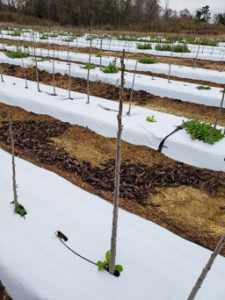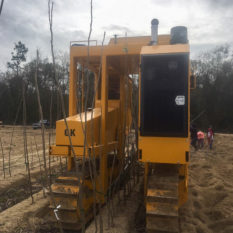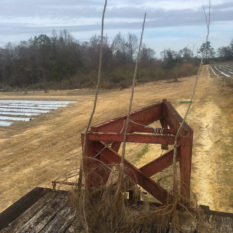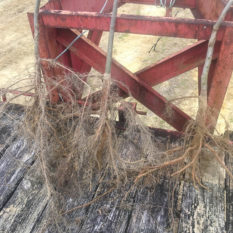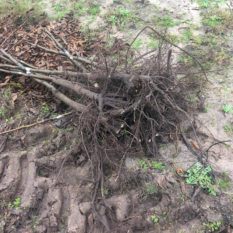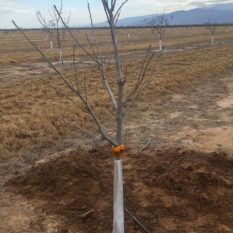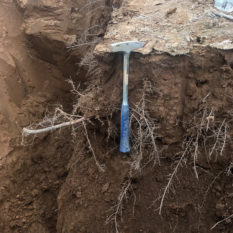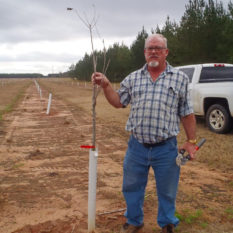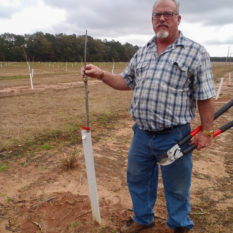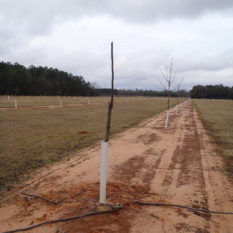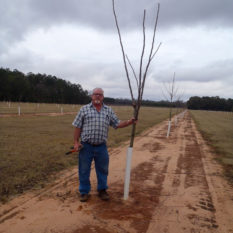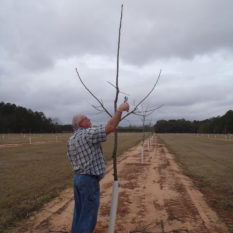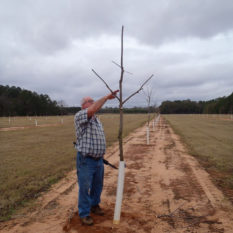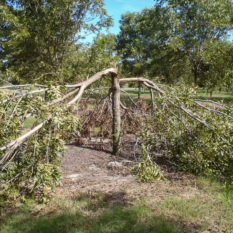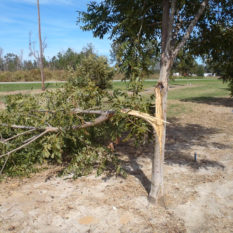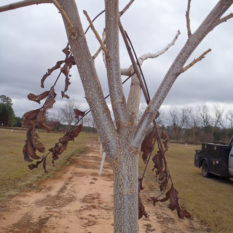Developmental Pruning of Nursery Pecan Trees
Pulling from his expertise and years of experience, Lamar Jenkins, a pecan propagation specialist, recommends pruning techniques to establish a tree's root system and structure at planting.

This two-year-old tree was planted from a seed and its root system and trunk are balanced.
In an effort to create more pecan acreage and pounds of pecans to sell, proper pruning of your newly set out trees seems to be, for the most part, ignored. I agree that nuts in the bag mean money in the pocket. However, this misconception that pruning a new tree delays pecan production is causing unnecessary tree loss. We should make growing a tree with the best root system and best structure our first priority. The top can be grown anytime.
Before real production starts, I believe that encouraging a proper regeneration of the root system can be achieved in the first four years. Fortunately, you can have your cake and eat it too! A pecan tree responds well to being cut on. If you don’t believe it, look at a tree that has been hedged. It will explode with new growth. So, let’s look at why a sound root system and tree structure are important and talk about a plan to achieve that goal.
The Perfect Seedling
I see the roots as having two jobs: to store and feed the tree, and to anchor the tree. The first job is obvious and acknowledged by all. The second job, I believe, is little understood or often misunderstood. The perfect seedling is a tree planted from a seed, never moved, and top-worked where it is. Why? The root system is never disturbed, and the entire taproot is intact. Anchorage of the tree is assured because the root system is in proportion to the top. There is as much or more under the ground in the root system as there is above the ground. This is demonstrated in the photo above. The tree in that photo was planted from a seed and is 2 years old.
This growth is not so with a set-out tree. When you set out a tree that has been planted and then dug up at a nursery, you must allow that tree to regrow a root system. As long as the top of the tree is out of proportion with the roots, the root system will work to feed that top and will be unable to reestablish itself. Since most plantings are much too large for planting a seed in place, we must rely on nurseries to provide the trees we need.
A Trip to the Nursery
Except for some bucket trees, most nursery trees being planted are bareroot trees. Most bareroot trees are planted in plastic, grafted in their second year, have the top grown for a year, and then dug. Some are budded the second year, and then dug in the third year, as in Photo 3. Either way, when the tree is dug, no matter how tall the top is, the root ball is about the same size. Even at this point, the top is out of proportion with the roots. But the two will never be this close again. So, planting is the time to give the tree a chance to correct itself. This time is when a plan to keep the top cut back for the first two to four years before the tree gets into production comes into play.
Helping a Tree to Adapt
So, you have purchased your tree. As we mentioned before, this purchase marks the first time this tree has been moved. Think of it this way: If I came to your house one night at 2 a.m. without warning, woke you from a sound sleep, wouldn’t even let you get out of your pajamas, put you on a plane to Istanbul, Turkey, dropped you off there, and told you this was your new home, how would you react? You would need a little time to adjust, wouldn’t you? You might even need a little help! That is what we are doing to these newly dug nursery trees. We have moved them away from their home and put them in Istanbul, Turkey—AKA your farm.
So, you should be asking yourself, “What can I do to make that tree’s adjustment easier?” Very briefly, I want to hit on a couple of things you should consider: 1) A pecan tree needs well-drained soil. Quit trying to plant those areas in your field that are too low and wet for the tree to do well, just because they are there; 2) You should have your irrigation ready at planting. Don’t make the tree suffer for water any more than it already has at digging. It takes a lot of water to rehydrate a tree. All too often, I’ve seen trees not receive water for some time, or even at all, after planting. That’s not helping a tree adjust! And it’s not a way to keep a good tree alive either; 3) I personally don’t like to see any nitrogen put on a freshly planted tree for the first year. On the other hand, I believe phosphorous and potassium are very helpful. Take soil samples ahead of time and see your county agent for recommendations for your site.
Year One: Planting Your Tree!
Before we get into how to prune a newly set-out tree (and although this article is not about how to plant a tree), I would offer one comment in that regard. Watch your planting depth. I have seen a lot of trees planted too deep. A pecan tree has a hard time getting past that. It presents a lot of problems. I had rather see a tree planted too shallow than too deep!
Alright, you have the tree in the ground. Now the $64,000 question is: How much do you cut off at planting?
Remember the root ball photo? The answer is the bigger the tree, the more you cut off. As a guide, follow this rule: If the tree is 7 feet tall or more, cut it off 2 to 6 inches above your 4-foot herbicide tube. For a 6-foot tree, use a 3-foot tube and cut the tree off right above the tube. For a 4-foot tree, cut a foot off the 3-foot tube and cut the tree off right above the tube. The bigger the tree, the more out of proportion it is, and the more you cut off the top. I know that’s a lot, but try to understand the reasoning. Believe me, the tree will respond.
Year Two: Pruning Tree Coming into Second Leaf
When the next year rolls around, what now? First, let’s talk about the time frame in which this work can be performed: anytime between when the tree goes dormant and, in the Southeast, the end of April is appropriate. My personal preference is March and April. Why? When you cut on a tree, it stimulates it a little, and if you have some warm temperatures early with a late freeze, you could see some damage. But I do understand those of you who have a lot of trees need to start earlier. I suspect the window out West could be shorter, maybe January to March.
In year two, I’d like to see you poll the tree back. In other words, cut all side limbs off. Pick your central leader and, as always, cut the top out, and poll all side limbs off. This cut will give you an excellent start to a tree free of bad angles, which we will discuss more in year three.
Now, suppose you planted your tree and did not cut any of it off. How do you catch up to where you need to be? Simple! Do what you should have done on year one; cut the tree off right above the herbicide tube and start over. You are just a year behind.
Year Three: Pruning Tree Coming into Third Leaf
Same time, different year. If you have followed the plan thus far, all you will need to do is reinstate the central leader, cutting the top out. That top could mean just about as far up as you can reach with loppers.
Speaking of loppers, let’s stop a minute to talk tools. Buy yourself a good pair of hand pruners and a good pair of long-handled loppers. If you follow the plan, these tools are all you will need. You could add a small 21-inch bow saw in years three and four, especially if you are a little behind and playing catchup. These tools are a great deal cheaper to use than front end loaders, chainsaws, and pruning towers when trying to save the tree later on.
So, reinstate the central leader, cut the top out of it, and tip prune side limbs according to a central leader. When done, it should resemble a Christmas tree. Every time you cut a limb or the top back, it forces that growth back and down. That means encouraging root growth and, very importantly, encouraging the trunk’s caliper. During this process, move the bottom limbs up, and you should be looking for your potential first limb from the bottom. We will hit on that more at the beginning of year four.
Be sure all limbs’ angles are good and not too narrow. The crotch of the limb should resemble a U instead of a Y. You need wide angles, especially low on the tree. The lower the limb, the more leverage the wind has on it, and the more likely it is to break out. The higher the limb is, the more give it has.
If you have not done the pruning that you should’ve done up to this point, you will have to play catch up. These photos show a three-year-old tree that was pruned none or very little. To eliminate the poor angles and catch the roots up, this tree had to be pruned extensively. A picture is worth a thousand words!
If you planted a 12- to 15-foot tree and cut nothing off, not even at planting, and it looks like the tree in Photo 16, cut it off about chest high and poll it completely back. Start all over. The reason this tree is leaning is that the root system and the trunk’s caliper are not strong enough to support the top’s weight. Cut it off and start over, or watch a good number of these trees lay over in the wind.
Year Four: Pruning Tree Coming into Fourth Leaf
If you have been doing your job up until now, many trees will need very little help by the fourth year. During this year, check and eliminate all narrow angles. You probably can’t reach the top, but if you can, cut the top out again to eliminate the possibility of crow’s foot and limbs that might compete with the central leader. Once the top gets up to 12 to 15 feet tall, I don’t worry so much about crow’s foot up there. That part of the tree usually develops enough give that you rarely see damage there.
Ok, you may have already chosen your first limb from the ground in year three. If not, move the bottom on up the tree and choose now. You will want to select a wide-angle limb, about 6 feet from the ground. That’s my preference in the Southeast as it allows for proper equipment use and adequate wind flow.
Everything we have covered up to now is pertinent, no matter where you are, East or West. I do acknowledge that the West has no disease pressure, lovely winds, blue skies almost all the time, and no hurricanes. So, as we talk about wind flow in the next paragraph, you western growers take a break.
If you are in the East and spray for fungi, I recommend 6 feet for the bottom limb, while out West I think those guys can go down to 5 feet or as low as they can get their equipment in. They have wind flow. East, you need to allow for it all you can. Most orchards in the East are too close to thickets and pine woods, which impede wind flow. With denser planting, wind flow is cut out even more. So, you should raise the canopy of your trees for maximum wind flow and sunlight. This increase in height will also facilitate your spray programs. With the cost of spray programs, you will need all the help you can get. Western growers are lucky in that regard.
Uh-Oh’s
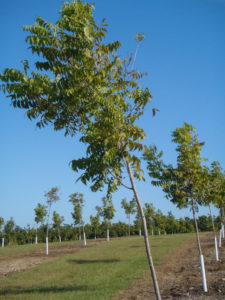
This tree leans to the left because its roots are not strong enough to support its top. Jenkins recommends that you start this tree all over if you planted a 12- to 15-foot tree and cut nothing off, not even at planting, and it looks like this one.
The photos below show some sights you can expect to see if you neglect this critical step in your orchard establishment. If you leave poor narrow angles, the limbs can and will break out. These breaks are almost 100 percent avoidable if you follow a pruning plan for the first four years. Prune hard! Like hair, the branches will grow back, and the tree will respond to being cut on. You can shape your tree in those first years before production and avoid heartbreaking loss of trees later.
As for trees damaged from hurricanes, some of those trees were planted too deep. If you are careful not to plant too deep and to prune these young trees early, I believe a large percentage of these trees would weather the storm and avoid less tree loss. Develop that root system, and the tree will have a much better anchor.
In Conclusion
I’m not claiming that this outline is the only way to establish a new tree. Nor am I claiming that if you follow this outline, it will prevent you from ever losing trees. However, I do believe that this plan will help you establish the best and strongest individual trees possible and will cut down significantly on tree loss throughout the years.

